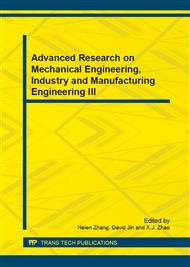p.380
p.384
p.388
p.392
p.396
p.400
p.404
p.408
p.412
Intelligence Based Control Strategy of Forming Process for Plastic & Rubber Products
Abstract:
The physical-chemical properties of plastic & rubber products such as rigidity and endurance etc not only are related to the factors of formulations of materials & supplies and structure size etc, but also mainly depend on the control effect of forming process in the vulcanizing phase. Aimed at the puzzle of being difficult to control resulted from uncertainty in vulcanizing phase, the paper proposed a sort of intelligence based control strategy. In the paper, it summed the control puzzle in complex vulcanizing phase, explored the cybernetics characteristic, researched on control strategy of complex process with uncertainty, proposed a sort of intelligence based control strategy, and constructed the control algorithm. The simulation experiment and engineering verification demonstrated that it could be stronger in robustness, and higher in control precision compared with PID controller. The research result shows that it is feasible and effective to the proposed intelligence based control strategy.
Info:
Periodical:
Pages:
396-399
Citation:
Online since:
August 2013
Price:
Сopyright:
© 2013 Trans Tech Publications Ltd. All Rights Reserved
Share:
Citation:


